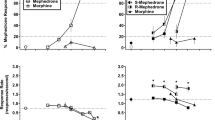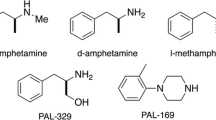Abstract
This experiment was designed to elucidate the neurotransmitter systems that mediate the discriminative stimulus effects of methamphetamine. Four pigeons were trained to peck one key following saline injections and a second key following methamphetamine injections (1.0 or 1.7 mg/kg, IM). Substitution tests revealed drug-appropriate responding following administration of the psychomotor stimulants methamphetamine, amphetamine and cocaine, the dopamine (DA) reuptake inhibitor bupropion, norepinephrine (NE) reuptake inhibitors imipramine and tomoxetine, and the serotonin (5-HT) releaser fenfluramine. Salinekey responding occurred following administration of the D1 agonist SKF-38393, the D1 antagonist SCH-23390, the α2 receptor agonist clonidine, the α1 antagonist prazosin, a nonselective β-antagonist propranolol and the selective 5-HT reuptake inhibitor fluoxetine. The D2/D3 agonist quinpirole produced drug-appropriate responding in two pigeons and partial substitution in the remaining two pigeons. The 5HT1A agonist 8-OH-DPAT produced drug-appropriate responding at higher doses (0.3–1.0 mg/kg), whereas much lower doses (0.003–0.1 mg/kg) antagonized the methamphetamine stimulus. The stimulus effects of methamphetamine were attenuated by pretreatment with prazosin, SCH-23390 and eticlopride, whereas pretreatment with propranolol and the 5-HT3 antagonist, MDL 72222, failed reliably to attenuate drug key responding. These results suggest that NE and DA reuptake inhibition and 5-HT release mediate the discriminative stimulus effects of methamphetamine as do the 5-HT1A and DA D1 and D2 receptors.
Similar content being viewed by others
References
Ando K, Yanagita T (1992) Effects of an antitussive mixture and its constituents in rats discriminating methamphetamine from saline. Pharmacol Biochem Behav 41:783–788
Bilsky EJ, Reid LD (1991) MDL 72222, a serotonin 5-HT3 receptor antagonist, blocks MDMA's ability to establish a conditioned place preference. Pharmacol Biochem Behav 39:509–512
Callahan PM, Cunningham KA (1993) Discriminative stimulus properties of cocaine in relation to dopamine D2 receptor function in rats. J Pharmacol Exp Ther 266:585–592
Eilam D, Szechtman H (1989) Biphasic effect of D-2 agonist quinpirole on locomotion and movements. Eur J Pharmacol 161:151–157
Glennon RA, Young R (1984) Further investigation of the discriminative stimulus properties of MDA. Pharmacol Biochem Behav 20:501–505
Grant KA, Barrett JE (1991) Blockade of the discriminative stimulus effects of ethanol with 5-HT3 receptor antagonists. Psychopharmacology 104:451–456
Helschober B, Miller MA (1991) Methamphetamine abuse in California. National Institute on Drug Abuse Research Monograph Series 115:60–71
Imperato A, Angelucci L (1989) 5-HT3 receptors control dopamine release in the nucleus accumbens of freely moving rats. Neurosci Lett 101:214–217
Järbe TUC (1982) Discriminative stimulus properties ofd-amphetamine in pigeons. Pharmacol Biochem Behav 17:671–675
Järbe TUC, Kroon ER (1980) Discriminative properties ofd-amphetamine in gerbils: tests for drug generalization and antagonism. Gen Pharmacol 11:153–156
Johanson CE, Barrett JE (1993) The discriminative stimulus effects of cocaine in pigeons. J Pharmacol Exp Ther 267:1–8
Kleven MS, Seiden LS (1992) Methamphetamine-induced neurotoxicity: structure and activity relationships. Ann NY Acad Sci 654:292–301
Mashurano M, Waddington JL (1986) Stereotyped behavior in response to the selective D-2 dopamine receptor agonist RU24213 is enhanced by pretreatment with the selective D-1 agonist SK&F 38393. Neuropharmacology 25:947–949
Miller MA (1991) Trends and patterns of methamphetamine smoking in Hawaii. National Institute on Drug Abuse Research Monograph Series 115:72–83
Oberlender R, Nichols DE (1988) Drug discrimination studies with MDMA and amphetamine. Psychopharmacology 95:71–76
Paris JM, Cunningham KA (1991) Serotonin 5-HT3 antagonists do not alter the discriminative stimulus properties of cocaine. Psychopharmacology 104:475–478
Peltier R, Schenk S (1991) GR38032F, a serotonin 5-HT3 antagonist, fails to alter cocaine self-administration in rats. Pharmacol Biochem Behav 39:133–136
Pradhan SN, Maickel RP, Dutta SN (eds) (1986) Pharmacology in medicine: principles and practice. SP Press International, Bethesda, Md., p 345
Schechter MD, Glennon RA (1985) Cathinone, cocaine and methamphetamine: similarity of behavioral effects. Pharmacol Biochem Behav 22:913–916
Schechter MD, Rosecrans JA (1973)d-Amphetamine as a discriminative cue: drugs with similar stimulus properties. Eur J Pharmacol 21:212–216
Seiden LS, Kleven MS (1991) Methamphetamine and related drugs: toxicity and resulting behavioral changes in response to pharmacological probes. NIDA Res Monogr 94:146–161
Sokoloff P, Giros B, Martres M-P, Bourthenet M-L, Schwartz J-C (1990) Molecular cloning and characterization of a novel dopamine receptor (D3) as a target for neuroleptics. Nature 347:146–151
Tatham TA, Zurn KR (1989) The MED-PC experimental apparatus programming system. Behav Res Methods Instr Comput 21:294–302
Wood DM, Lal H, Emmett-Oglesby M (1984) Acquisition and recovery of tolerance to the discriminative stimulus properties of cocaine. Neuropharmacology 23:1419–1423
Young R, Glennon RA (1986) Discriminative stimulus properties of amphetamine and structurally related phenylalkylamines. Med Res Rev 6:99–130
Author information
Authors and Affiliations
Rights and permissions
About this article
Cite this article
Sasaki, J.E., Tatham, T.A. & Barrett, J.E. The discriminative stimulus effects of methamphetamine in pigeons. Psychopharmacology 120, 303–310 (1995). https://doi.org/10.1007/BF02311178
Received:
Revised:
Issue Date:
DOI: https://doi.org/10.1007/BF02311178




